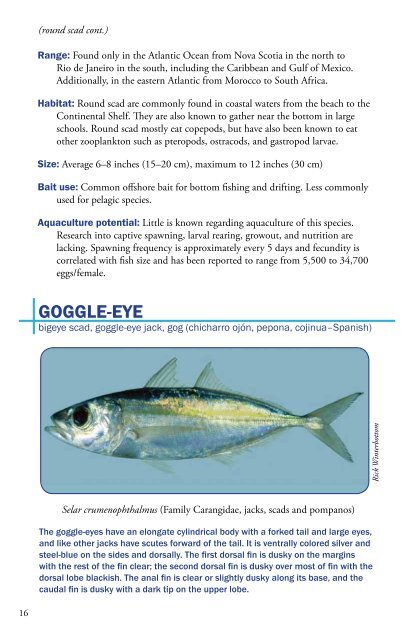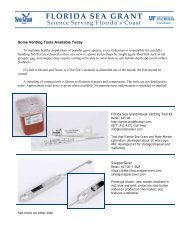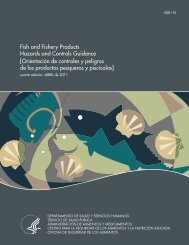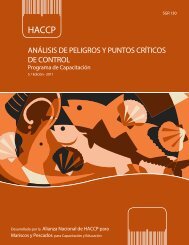MARINE BAITFISH
Growing Marine Baitfish - Florida Sea Grant
Growing Marine Baitfish - Florida Sea Grant
Create successful ePaper yourself
Turn your PDF publications into a flip-book with our unique Google optimized e-Paper software.
(round scad cont.)<br />
Range: Found only in the Atlantic Ocean from Nova Scotia in the north to<br />
Rio de Janeiro in the south, including the Caribbean and Gulf of Mexico.<br />
Additionally, in the eastern Atlantic from Morocco to South Africa.<br />
Habitat: Round scad are commonly found in coastal waters from the beach to the<br />
Continental Shelf. They are also known to gather near the bottom in large<br />
schools. Round scad mostly eat copepods, but have also been known to eat<br />
other zooplankton such as pteropods, ostracods, and gastropod larvae.<br />
Size: Average 6–8 inches (15–20 cm), maximum to 12 inches (30 cm)<br />
Bait use: Common offshore bait for bottom fishing and drifting. Less commonly<br />
used for pelagic species.<br />
Aquaculture potential: Little is known regarding aquaculture of this species.<br />
Research into captive spawning, larval rearing, growout, and nutrition are<br />
lacking. Spawning frequency is approximately every 5 days and fecundity is<br />
correlated with fish size and has been reported to range from 5,500 to 34,700<br />
eggs/female.<br />
GOGGLE-EYE<br />
bigeye scad, goggle-eye jack, gog (chicharro ojón, pepona, cojinua–Spanish)<br />
Rick Winterbottom<br />
Selar crumenophthalmus (Family Carangidae, jacks, scads and pompanos)<br />
The goggle-eyes have an elongate cylindrical body with a forked tail and large eyes,<br />
and like other jacks have scutes forward of the tail. It is ventrally colored silver and<br />
steel-blue on the sides and dorsally. The first dorsal fin is dusky on the margins<br />
with the rest of the fin clear; the second dorsal fin is dusky over most of fin with the<br />
dorsal lobe blackish. The anal fin is clear or slightly dusky along its base, and the<br />
caudal fin is dusky with a dark tip on the upper lobe.<br />
16








